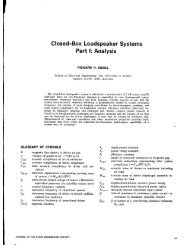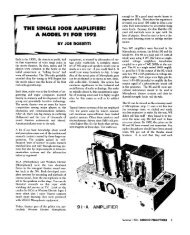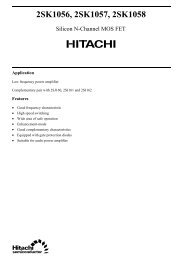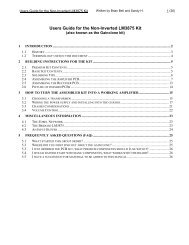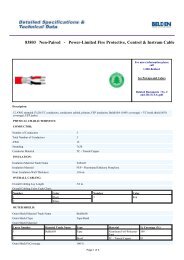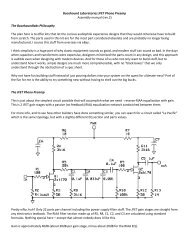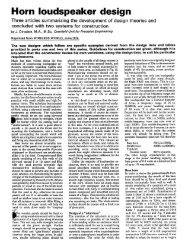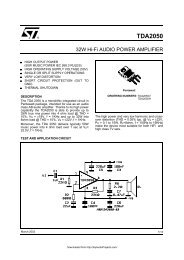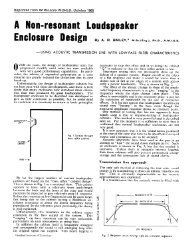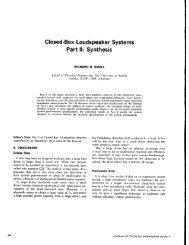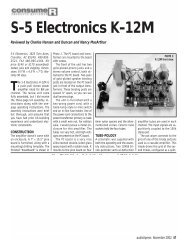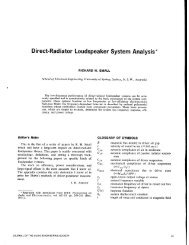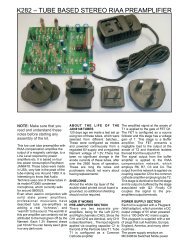Basic Tube Power Supplies - DIY Audio Projects
Basic Tube Power Supplies - DIY Audio Projects
Basic Tube Power Supplies - DIY Audio Projects
- No tags were found...
You also want an ePaper? Increase the reach of your titles
YUMPU automatically turns print PDFs into web optimized ePapers that Google loves.
<strong>Power</strong> Supply Design for Vacuum <strong>Tube</strong> AmplifiersMatt Renaud, January 2012IntroductionIt’s time for a little confession: I don’t always spend as much time on my power supply designs as Ishould. Sometimes I get excited about my latest circuit and after looking for just the right tubes, outputtransformers, coupling caps, and low noise resistors, the power supply design becomes almost an afterthought. Sometimes things turn out ok and there are no problems. Other times I end up with badvoltages, unacceptable power supply sag, channel crosstalk, or worst of all, a hum that I just can’t seemto eliminate. It’s at these times that I always wish I had taken a little more time to get it right.The truth is, there is no reason to suffer power supply set backs like this. The design of basic tube powersupplies is actually very straight forward. And, if we rely on the excellent work of those who’ve comebefore us (O. H. Schade, N. H. Roberts, D. L Waidelich, H. J. Reich), we don’t even need to tackle anyadvanced math or taxing mental gyrations to arrive at some truly excellent power supply designs.What I’d like to do here is to walk through a design process first recommended by O. H. Schade 1 in1943 and presented in a slightly modified version by Herbert Reich in 1944 in his book “Theory andApplications of Electron <strong>Tube</strong>s” 2 . Now, the state of electronics has changed somewhat in the 67 yearssince Schade first published his landmark work. As such, I will present again, a somewhat modifiedversion of this process more suited to today’s amp builders and hobbyists. This process uses only simpleequations and Schade’s original graphs as modified by Reich. Even those builders who are unfamiliar oruncomfortable with advanced mathematics should have no problems using this approach. The entireprocess relies on assuming that the rectifier, when conducting, acts like a resistor. So if you can figureout how this resistance acts at your planned load current, you can get your power supply design justright.I am going to work through the procedure by designing a supply for a mythical low power stereoamplifier. It’s a stereo single ended class A design I’ll refer to as the Ghost amp. I will first present theprocess for each step and then fill in some numbers to show how the process works. I urge readers toread the entire design process first and then go back and look closely at the math. It’s not advanced, butit can be a little intimidating the first time through. As I work though the process, I introduce newvariables and identify them with unique letters and symbols.Part 1 - The <strong>Basic</strong> <strong>Power</strong> Supply<strong>Power</strong> Supply Constraints and ChoicesThe first step is to determine the total load for your power supply. This is the B+ voltage required byyour amp, and the total load current for all plate supply and screen supply voltages. If you are buildingfor a stereo amplifier, be sure to include both channels. I will refer to these as VL and IL respectively.1 Schade, O. H., Proceedings of the I.R.E, 31, p341-361, (1943)2 Reich, Herbert J, “Theory and Applications of Electron <strong>Tube</strong>s”, 2 nd Ed., McGraw-Hill, 1944http://diyaudioprojects.com/Technical/<strong>Tube</strong>-<strong>Power</strong>-<strong>Supplies</strong>/Page 1 of 21
Also required is the mains voltage and frequency where the amp is to be used. This will affect yourtransformer selection and your overall power supply design. These I will refer to as VM and fMrespectively.For the Ghost amp, each channel requires a B+ voltage of 250v at 59mA at idle and 65mA at peakoutput. So VL=250v and IL= 2 *65mA = 130mA. Here in North America the main power is 120v at 60Hz so VM=120v and fM=60Hz. These will be our starting points. So summarizing, we are starting withthe following conditions:V L= 250vI L= 130mAV M= 120vf M= 60HzNow we need to choose a topology. Our basic options are a single diode half wave rectifier, a dual diodefull wave rectifier (center tapped transformer secondary), or a dual diode full wave voltage doubler.There are other topologies of course, but these three are the most suitable for high fidelity amplifiers.For the Ghost amp I will choose a full wave dual diode rectifier. This topology has advantages over thehalf wave circuit in that the ripple is lower and the ripple frequency is twice as high making it easier tofilter. The dual diode voltage doubler shares these characteristics but since the required VL is fairly low(by tube amp standards), there is no need to deal with the added complexity of the voltage doubler.I am also going to choose to use a capacitor input filter. I could also use a choke input filter, however thechoke would require a much higher transformer secondary voltage and a larger choke than the capacitorinput filter. This would drive up the size and cost of the power supply and small and cheaper is betterthan large and more expensive.The First Calculations - Currents and VoltagesNow that we have the basic electrical constraints and have chosen a topology, it’s time to start estimatingthe electrical parameters which will drive the power supply’s operation. The first of these are the diodeplate currents. Once calculated these will allow us to choose a suitable rectifier tube for our amplifier.The average plate current in our full wave rectifier is simply one half the total load current; one half foreach diode.I P= I L2 = 130mA = 65mA (eq. 1)2The peak plate current is more complex. Because the input capacitor only partially discharges on eachhalf cycle, the diode can only conduct on that portion of the following cycle when the plate voltageexceeds the voltage to which the capacitor discharged between cycles. This means that the capacitorcharging current must be significantly greater than the average plate current. Here we are going to makean assumption. Based on the typical performance of vacuum tube rectifiers we are going to assume thatthe effective peak charging current per plate is four times the average current. Later we will refine thisPage 2 of 21http://diyaudioprojects.com/Technical/<strong>Tube</strong>-<strong>Power</strong>-<strong>Supplies</strong>/
estimate based on our preliminary results. So using this estimate yields the following result for the peakplate current.Î P= 4I P= 4 *65mA = 260mA (eq. 2)Now that we know the peak plate current it is time to choose a rectifier tube. Making this decisionrequires checking the tube data sheets, looking at max ratings and voltage drops, and applying somejudgement and experience. There are some basic rules to apply which make this task easier. First, andmost importantly, the maximum tube ratings must not be violated. We already have an estimate of themaximum plate current. But what about the diode peak inverse voltage. The diode will see this voltagewhen the capacitor is at max voltage, i.e VL, and the transformer winding is at the peak opposite voltage.Since we can’t as yet estimate voltage drop in the rectifier, it is good to assume it’s zero so the peakinverse voltage on the diode will be the load voltage plus the peak AC voltage from half of the centertapped secondary. Since we don’t know our secondary voltage yet we’ll estimate it’s RMS value as thethe same as VL. This means that the peak inverse diode voltage will be as follows.ˆV Di= V L+ 2V L= ( 1+ 2 )V L= 2.41*250v = 603v (eq. 3)There is one other important parameter which is the diode voltage drop. While the amp is at idle, thevoltage drop across each diode will be one voltage, and when the amp is approaching full power thecurrent draw will be greater and the diode voltage drop will be greater. This will result in what is knownas power supply sag. For class A operation (such as our Ghost amp), sag is generally not a majorconsideration (current change is only ~10%), for class AB or B operation, sag can become a major issue.Because we are shooting for a high fidelity amplifier we will want to limit sag as much as possible.It should be noted that minimizing sag is not always the best design choice. Particularly in guitaramplifiers, power supply sag can create unique distortion and tonal qualities which are actually quitedesirable. But for musical reproduction this is not generally the case so, for the Ghost amp, we want tolimit sag as much as possible.Choosing the Rectifier <strong>Tube</strong>So, with all these constraints, how do we go about choosing just the right tube for the job? Lets examinethe following graph. This is a collection of vacuum tube rectifier voltage drops as a function of platecurrent. It shows just how much drop there is for each tube and allows us to get a feel for how much sagto expect for a given tube.http://diyaudioprojects.com/Technical/<strong>Tube</strong>-<strong>Power</strong>-<strong>Supplies</strong>/Page 3 of 21
Figure 1 - Vacuum <strong>Tube</strong> Rectifier Forward Voltage DropIn figure 1, the tubes with very steep lines (such as the 5Y3, popular in guitar amplifiers) have thehighest voltage drop for a given current and will exhibit the most sag or change in voltage as the currentincreases. Likewise, tubes with shallow lines (such as the 5AR4/GZ34) have the lowest voltage drop fora given current and will exhibit the least sag as current increases. But the question remains as how arewe to choose.The lines in figure 1 only extend to the maximum allowed tube current. We know the peak current forthe Ghost amp is 260mA, so this eliminates the 6X4 and the 25Z5. Since we already decided we wouldlike to minimize sag we could go with the 5AR4. However this is a large and rather expensive tube.We’ll keep this in mind but something cheeper and smaller would be nice. We could go with the 3DG4but this will require a non-standard heater voltage and the same applies to the 35W4/35Z5GT. Our nextcandidate is the 6CA4. This is a small envelope tube which is still in production by a number ofmanufacturers. A quick check of the data sheet shows that the peak inverse voltage for this tube is 1200vhttp://diyaudioprojects.com/Technical/<strong>Tube</strong>-<strong>Power</strong>-<strong>Supplies</strong>/Page 4 of 21
and the max current is 500mA, both values provide significant margin. This tube looks like a goodcandidate. Now we need to check it’s other ratings.We have chosen a capacitor input filter so we need to check the allowed operational ratings. The chartbelow is directly out of the GE data sheet. It shows under what conditions it is permissible to use acapacitor or choke input filter with this tube.Figure 2 - 6CA4 Design Rating ChartWe have a maximum probable per plate DC output current of 65mA. The maximum probable plate RMSvoltage will probably be between 250v and 300v (adding a little margin over that used in equation 3) sowe can use this tube with the capacitor input filter and still have significant margin. This is just aneducated guess at this point. We’ll check back later to make sure we’re still ok.Also, according to the data sheet, the typical conditions all assume a 50µf capacitor. I’m just going to gowith the recommendation in the data sheet and choose something close to this; a standard value 47µfcapacitor.C L= 47µ fThere is a temptation at this point to attempt to maximize this first capacitor, however this can be anunwise decision. The larger the first capacitor, the less it will discharge between cycles. This may seemhttp://diyaudioprojects.com/Technical/<strong>Tube</strong>-<strong>Power</strong>-<strong>Supplies</strong>/Page 5 of 21
like a good thing (e.g. it reduces ripple voltage), but it means that the conduction angle (that portion ofthe cycle over which the capacitor recharges) will be much shorter. This will drive up the peak diodecurrent and can lead to either damaging the tube or causing unnecessary voltage drop and excessivetransformer heating. Here, smaller is actually better. The total ripple may be higher, but we’ll deal withthat in the filter design.This process of choosing a rectifier tube may seem somewhat arbitrary at this point; and in some aspectsit is. However, as designers become more experienced and familiar with the various rectifier tubes, mosttend to settle on one or two favorites, and only stray when they really need something different. Nowthat we have chosen an appropriate tube and input capacitor value, it’s time to begin estimating theperformance of our design.Rectifier CalculationsThe first thing we need to do is estimate the peak and average resistances for our rectifier diodes. Sincewe already have the peak current estimate from equation 2 we can use this along with the voltage dropfrom figure 1 to calculate the peak diode resistance. From figure 1, for the 6CA4 at 260mA, the forwardvoltage drop is 28v (This information is also available on the data sheet.). This gives the peak dioderesistance as follows.ˆr p= ˆV d=28v = 108Ω (eq. 4)Î P260mAUp to this point we have been making simple calculations based on simple circuit theory and data sheets.Now we need to fall back on some of the work already accomplished by Schade back in 1943. Schadefound that the value of the average diode resistance could be calculated (to within an acceptable marginof error) from the peak diode resistance by a simple multiplicative factor. So by following Schade’ssolution we get the following.r p= 1.14 ˆr p= 1.14 *108Ω = 123Ω (eq. 5)Now we need to find the total peak and average resistances which include the effects of the transformerwinding resistances. Obviously this presents a slight problem as we haven’t yet chosen a power supplytransformer. So again we will have to make an estimate. The effective transformer secondary windingresistance is given by the following equation.R S= R secondary+ N 2 R primary(eq. 6)where Rsecondary is the secondary winding resistance per sectionRprimary is the primary winding resistanceand N is the voltage step up ratio per section.http://diyaudioprojects.com/Technical/<strong>Tube</strong>-<strong>Power</strong>-<strong>Supplies</strong>/Page 6 of 21
For a modern vacuum tube power transformer, the resistance of a typical secondary winding of 250v to300v, rated at 150mA, is on the order of 50Ω and the primary may be on the order of 10Ω. If we assumea 250v RMS secondary voltage per section, the voltage step up ratio is as follows:N = V secondaryV M= 250v = 2.08 (eq. 7)120vCombining this result with our other estimates, equation 6 yields an effective transformer resistance of~93Ω per section. At this point it’s a good idea to make a check on our rectifier data sheet for theminimum allowed source resistance. If the source resistance is too low then the initial inrush current tocharge the capacitor will exceed the limits of the rectifier. So lets return to the data sheet.Figure 3 - 6CA4 Source Resistance Rating ChartAccording to the graph in Figure 3, at the 250v RMS voltage we assumed previously, the minimumallowed source resistance is ~125Ω. However, if you look at the note on the graph you’ll find that thisminimum resistance is only required if “hot switching” is involved. Hot switching is where the highvoltage supply is activated after the tube filaments have come to temperature. If we apply the highvoltage load at the same time as the filament voltage, then this resistance requirement can besignificantly relaxed. So now we have a decision to make. Either we can insert a ~40Ω resistor in serieswith each plate (which will result in additional loss in our power supply) or we can put a restriction onthe design that there will be no high voltage “standby” switch.http://diyaudioprojects.com/Technical/<strong>Tube</strong>-<strong>Power</strong>-<strong>Supplies</strong>/Page 7 of 21
In reality, there is almost never a reason to include a standby switch in a piece of audio equipment with avacuum tube rectifier. As such, we’ll make the decision to leave out the additional resistance and foregousing a standby switch in our design. This is another design constraint of which we’ll need to keep track.Getting back to our 93Ω estimated transformer resistance, we’ll now use this estimate to calculate thetotal effective values for the peak and average supply resistances. Here we simply add the transformerresistance estimate to those values calculated in equations 4 and 5.ˆR s= ˆr p+ R S= 108Ω + 93Ω = 201Ω (eq. 8a)R s= r p+ R S= 123Ω + 93Ω = 216Ω (eq. 8b)There are three more pieces if information we need before we go back to Schade’s work. The first isequivalent load resistance presented by the amplifier RL. This is found by simply dividing the loadvoltage by the load current. So for the Ghost Amp we have the following:R L= V LI L= 250v = 1.92kΩ (eq. 9)130mAThe second piece of information we need is a “frequency time constant” for the rectifier load. This is ameasure of the effective discharge time in radians for each half cycle and is shown in the graphs as ωRC.It is calculated as follows:ω RC = 2π f MR LC L= 2 *π *60Hz *1.92kΩ* 47µ f = 34.0 (eq. 10)And the final piece of information is the source resistance to load resistance ratios. These will allow usto check some of our previous assumptions, determine the efficiency of the rectifier, and to chose anappropriate transformer. The resistance ratios are found as follows:ˆR sR sR L= 201Ω = 0.1051.92kΩ(eq. 11a)R L= 216Ω = 0.1121.92kΩ(eq. 11b)Now that we have all this information , it’s time to return to Schade (and Reich).Assumption Check and Iterative CorrectionNow that we have initial estimates for all the rectifier data, the first thing we want to do is beginchecking some of the assumptions we made along the way. All the way back in equation 2 we made theassumption that the peak diode current was four times the average plate current. I also said that wewould refine this estimate base upon our initial results. Now is the time for that refinement. Using theresistance ratio value of equation11a it is now possible to check this initial assumption. Reichreformatted and published Schade’s plots for performing this check.Page 8 of 21http://diyaudioprojects.com/Technical/<strong>Tube</strong>-<strong>Power</strong>-<strong>Supplies</strong>/
Figure 4 - Diode Current Peak and RMS Ratios after SchadeUsing our calculated values, n=2, nωRC is 64, and the peak resistance ratio from equation 11a, inconjunction with the lower graph we find that the peak current is better estimated as 5 times the averageplate current. In light of this, we now need to recalculate equations 2, 4, 5, 8, and 11 to arrive at betterestimates of these parameters.Î P= 5I P= 5 *65mA = 325mA (eq. 2’)ˆr p= ˆV dÎ P=33v = 102Ω (eq. 4’)325mAr p= 1.14 ˆr p= 1.14 *102Ω = 116Ω (eq. 5’)ˆR s= ˆr p+ R S= 102Ω + 93Ω = 195ΩR s= r p+ R S= 116Ω + 93Ω = 209ΩˆR sR sR L= 195Ω1.92kΩ = 0.102R L= 209Ω1.92kΩ = 0.109(eq. 8a’)(eq. 8b’)(eq. 11a’)(eq. 11b’)The values found in equations 11a’ and 11b’ do not differ significantly from those found initially with11a and 11b, so a second iteration is not required. In some instances where the load currents are high orVL is relatively low, another iteration may be required, but in general, one iteration of these equations issufficient. If we check the 325mA peak current against the 500mA tube limit we find that there is stillsignificant margin. Choosing a different rectifier is not required.http://diyaudioprojects.com/Technical/<strong>Tube</strong>-<strong>Power</strong>-<strong>Supplies</strong>/Page 9 of 21
Rectifier Efficiency - The Heart of the MaterSchade published (and Reich reformatted) a series of graphs showing rectifier efficiency for variousconfigurations. These graphs allow us to determine the efficiency of the rectifier and hence the requiredoutput voltage of the transformer. Here is Reich’s reformatted graph for a dual diode, full wave centertapped voltage rectifier circuit.Figure 5 - Rectifier Efficiency for Full Wave Rectifier with Capacitor FilterIn order to use the graph in figure 4 we need to find the intersection of our value for ωRC with theappropriate resistance ratio curve. So using the result from equation 10 (ωRC =34.0) we find this pointon the x axis. In equation 11b’ we found the refined resistance ratio to be 0.109 (from the first iteration)which is approximately half way between the 0.10 and 0.125 curves. Locating this point on the chart, wefind the efficiency factor to be 0.74. We’ll refer to this value as the rectifier efficiency, Er. In general wehttp://diyaudioprojects.com/Technical/<strong>Tube</strong>-<strong>Power</strong>-<strong>Supplies</strong>/Page 10 of 21
want the ωRC value from equation 10 to be to the right hand side of the knee in the curves of figure 5.This helps ensure that as the current draw on the supply fluctuates (i.e. the effective RL changes) theefficiency and hence the output voltage remains fairly constant. This is referred to a good loadregulation.What the rectifier efficiency really means is that the ratio of the DC output voltage, Edc, to the peaktransformer secondary voltage per section, Em, (or 1.414 times the RMS secondary voltage) is 0.74. Thisis shown mathematically as follows.E r= E dcE M(eq. 12)Reformatting equation 12 allows us to determine the required transformer peak secondary voltage persection.E M= E dcE r= 250v0.74= 338v (eq. 13)To find the required RMS secondary voltage per section we simply divide the peak voltage by the squareroot of 2.E RMS= E M2 = 338v = 239v (eq. 14)1.414Before we go forward, it’s time to make one more check on our rectifier data sheet. From our calculateddata and figure 5 we determined that the rectifier efficiency was 0.74. We need to check if this isacceptable. The following is the efficiency rating chart from the 6CA4 data sheet.http://diyaudioprojects.com/Technical/<strong>Tube</strong>-<strong>Power</strong>-<strong>Supplies</strong>/Page 11 of 21
Figure 6 - 6CA4 Rectifier Efficiency Ratings ChartOur operating point for the Ghost amp (65mA per plate and 0.74 efficiency) is well within the area ofpermissible operation for this tube, so we’re still ok. This means that the 6CA4 has passed the lasttechnical hurdle and it totally suitable for our power supply. With the one design caveat of no hotswitching allowed.Choosing a TransformerNow when Schade and Reich did their work, there were no standard transformers nor companies sellinga product line of tube transformers. It was simply assumed that whatever transformer was requiredwould be wound for the voltage needed. Today we need to approach this aspect of power supply designa little differently.It is virtually impossible that we’ll be able to find a transformer which exactly matches our 239vrequirement from equation 14. But in reality that’s not a problem because there are some more things toconsider. First, tubes are not like integrated circuits with respect to power supply requirements. Unlessyour designs are pushing the tubes right to their limits, most tube amplifier circuits operate equally wellwith power supply variations as large as +/- 20%. For our transformer that means somewhere between192v and 287v. Suddenly exactly matching that 239v number doesn’t seem nearly so important. Second,unless you really like hum, this power supply is going to need some filtering. At 130mA, this means thefilter is going to cost you somewhere between 20v and 30v and possibly much more if you use only RCfiltering. So as a matter of principal, I shoot for a voltage about 20 to 30 volts above my target voltageand then design the filter stages accordingly.http://diyaudioprojects.com/Technical/<strong>Tube</strong>-<strong>Power</strong>-<strong>Supplies</strong>/Page 12 of 21
Now you may be thinking that we set VL as 250v right at the start. How can it be ok to simply increasethe voltage 20v to 30v without rerunning all the equations? The answer to this question lies in thepercentage change I am assuming (~12%) which is fairly small and in how VL affects the calculations.Increasing the output voltage while maintaining the current draw increases the rectifier peak inversevoltage (equation 3), but a quick check shows plenty of margin so that shouldn’t be a problem. Itincreases the transformer voltage step up ratio and hence the effective secondary resistance by about11Ω (equations 6 and 7) increasing the total source resistances in equation 8. It also increases theeffective load resistance calculated in equation 9 (to 2.15kΩ). However, in the efficiency numberscalculated in equation 11, these increases tend to offset each other so the overall effect on the resistanceratios and hence rectifier efficiency is small. In reality, a 20v to 30v change on top of a 250v supply isreally not much of a change at all.If you have any questions, then you should rerun the numbers to convince yourself. With practice andexperience you’ll begin to get a feel for how different parameters affect the design point and rerunningthe equations usually won’t be required.So now we want a transformer with a secondary voltage of somewhere between 259v and 269v RMSper section or between 518v and 538v RMS for the entire secondary. A quick check of a supplierswebsite quickly shows that this is not a very common voltage range. However what is a common voltageis 550v or 275v RMS per section. So, we settle on this voltage and will if we need to slightly reduce thevoltage, we’ll add a dropping resistor in the filter.Assessing the Design So FarSo where does all this calculation leave us? Returning to equation 12, we can rearrange the equation toget the dc output voltage as a function of the peak secondary voltage per section. Also, by rearrangingequation 14 we can express the peak voltage as a function of the RMS voltage. By combing the two wearrive at our output voltage as follows:E dc= 2E RMSE r= 1.414 *275v *0.74 = 288v (eq. 15)This voltage is 38v higher than our target voltage of 250v. However, this is all right as it gives us somevoltage drop to apply to our smoothing filter.The other question is now how much ripple are we going to have to filter. This is again a place to fallback on our friend Schade. As part of his work, he published a very nice plot showing ripple factor as afunction of ωRC and the peak resistance ratio as calculated in equation 11a. This value will allow us todetermine that total ripple output by our power supply.http://diyaudioprojects.com/Technical/<strong>Tube</strong>-<strong>Power</strong>-<strong>Supplies</strong>/Page 13 of 21
Figure 7 - Ripple Factor for Capacitor Loaded Rectifier CircuitsUsing our value of ωRC from equation 10 (34) and the peak resistance ration from equation 11a’ (0.102)we determine that the ripple factor, rf, is approximately 0.018. Using this information the total ripple forour supply is calculated as follows:V r= r fE dc= 0.018 *288v = 5.18v (eq. 16)This level of ripple may look high, however it is actually very typical of this type of power supplydesign. I consider this an excellent result for input to our smoothing filter.Part 1 SummarySo summarizing our design we have a supply utilizing a transformer 550vct secondary, a 6CA4 rectifiertube, and a 47µf input capacitor. Load regulation is good and we have ample rectifier margin to ensuregood operation and long tube life. Supply hot switching will not be utilized to minimize inrush currentsat startup. Our output voltage is 288v going into the smoothing filter leaving 38v for filter voltage lossestherein. Our ripple going into the filter is 5.18v (1.8%) or approximately -35dBv below the operatingvoltage. This is a good design solution.In the next section we’ll be discussing the smoothing filter. This will take the output of our basic powersupply and make it suitable for feeding our high fidelity Ghost amp.http://diyaudioprojects.com/Technical/<strong>Tube</strong>-<strong>Power</strong>-<strong>Supplies</strong>/Page 14 of 21
Part 2 - The Smoothing FilterSetting the Filter RequirementsOnce the rectifier portion of the supply is complete, it’s time to begin thinking about the filter. The mostobvious question at this point is “How much filter do I really need?” Unfortunately there is no easyanswer to this question. The answer is going to depend on the type of load on the supply and how it’sgoing to be used. A stereo amplifier requires more filtering than a mono-block design. A class A outputstage requires less filtering than a class AB output stage. So we are going to need to set somesimplifying assumptions.In chapter 14 of his book “Theory and Applications of Electron <strong>Tube</strong>s”, Herbert Reich gives some goodrules of thumb for just how much ripple may be acceptable for various types of circuits. Based onReich’s recommendation I generally require a B+ voltage ripple level of at least -90dBv or about0.0031% for any general purpose audio amplifier such as the Ghost amp. So this is where we’ll startwith our filter design.Smoothing FactorsWhen dealing with power supply filters it is generally easiest to talk in terms of smoothing factors. Asmoothing factor is simply a numeric factor for how much the ripple is reduced. For example, asmoothing factor of 100 will reduce 5 volts of ripple to 0.05 volts of ripple. Another way to think aboutthis is that the smoothing factor in dBv subtracted from the power supply ripple level in dBv gives theoverall ripple level at the filter output.As an example, the output of out ghost amp power supply was 288v with 5.18v rms of ripple. Thisyields a ripple level of -35dBv. In order to achieve our ripple target of -90dBv we’ll need another-55dBv of ripple reduction from our filter or a total smoothing factor of 562. The smoothing factor andit’s dBv equivalent are related by the following relation.F s( dBv)= 20log( F s ) = 20log( 562) = 55dBv (eq. 17a)F S= 10⎛ F S( dBv)⎞⎝⎜ 20 ⎠⎟ 55dBv= 10( 20 ) = 562 (eq. 17b)Filter TopologiesThere are many possible filter topologies which may be used to achieve the required ripple reduction.They may be passive or active, single or multi-stage, and closed or open loop. For simplicity’s sake, Iwill only be addressing two types of passive filter stages; the RC filter stage and the LC filter stage.Now a DC power supply filter is a simple circuit which takes advantage of the frequency dependentimpedance characteristic of capacitors and/or inductors to separate the AC ripple from the DC supplyvoltage. Also, one of the real beauties of filter stages in that smoothing factors for cascaded stages aremultiplicative. So if you have three cascaded filter stages with smoothing factors of FS1, FS2, and FS3,then the total smoothing factor is given by the following relation.http://diyaudioprojects.com/Technical/<strong>Tube</strong>-<strong>Power</strong>-<strong>Supplies</strong>/Page 15 of 21
F ST= F S1× F S2× F S 3(eq. 18)The only catch is that equation 18 only holds if in each stage the reactance of the series impedanceelement at the primary ripple frequency is about 20 times the reactance of the shunt element at the samefrequency. Normally this isn’t a problem but it is one thing that we’ll have to check later. With thesethoughts in mind, lets look at the two types of filter stages stages mentioned above.The RC Filter StageThe RC filter stage is the simplest in operation of all the filter stages. This stage simply acts as afrequency selective voltage divider where the shunt impedance is frequency dependent. Consider thefollowing simple diagram.Figure 8 - RC Filter StageAt DC (i.e zero frequency) the capacitor in figure 8 is going to act as an open circuit and the DC outputvoltage will be the equal to the input voltage minus the voltage drop in R1. But what about the ACvoltage (i.e. the ripple)? At AC the capacitor has a finite reactance given by the following relation.X C1=12π f rC 1(eq. 19)Because we are using a full wave rectifier, the ripple frequency fr is equal to two times the mainsfrequency. Using this information and the normal voltage divider relation, we can derive an equation forthe smoothing factor for this filter section. It is given in the following relation.1F S= V R +ripple−in 2π f=rCV ripple−out12π f rC= 2π f rRC +1 (eq. 20)Using some typical values for this stage results in some interesting results. Lets set R=150Ω andC=100µf. This results in a ripple reduction factor for this stage as follows.http://diyaudioprojects.com/Technical/<strong>Tube</strong>-<strong>Power</strong>-<strong>Supplies</strong>/Page 16 of 21
F S= 2π f rRC +1 = 2 × π × ( 2 × 60Hz) ×150Ω ×100µf +1 = 12.3 (eq. 21)This ripple reduction factor (21.8dBv) is fairly good. However at our load of 130mA, this stage has avoltage drop of 19.5v (150Ω x 130mA). This result only leaves 18.5v of our original 38v margin. If wecascade two of these stages we’ll only use up one volt over our design margin, but using equation 18 thetotal smoothing factor will only be 151.3 (12.3 x 12.3) or 43.6dBv. Subtracting this from our input ripplelevel of -35dBv (from the power supply design summary) results in a total ripple of -78.6dBv. This is afull 11.4dBv above our desired result. Clearly something else must be done.In cases like this, the best choice of action is to judiciously increase the value of the filter capacitor. Thiswill not increase the filter loss as increasing the resistance would but it does mean more inrush currentand a longer time for everything to come to final voltage at startup.The desire was to have a ripple reduction factor of 562 or 55dBv (from equation 17). If we are tocascade two stages then based on equation 18, the desired single stage smoothing factor is the squareroot of 562 or 23.7. In order to obtain this smoothing factor lets reformulate equation 20 to solve for C.This reformulation yields the following.C = F s −12π f rR =23.7 −1= 200µf (eq.22)2 × π × ( 2 × 60Hz) ×150ΩSo, by simply increasing the two filter capacitors from 100 to 200µf we obtain the full ripple reductionrequired. This is a good time to check our one assumption concerning cascaded filter stages. At ourprimary ripple frequency of 120Hz, the 200µf capacitor has a reactance of 6.6Ω. The ration of R to Xcusing this value is 22.6 so we are ok with this design. Finally, a quick check using equation 20 shows afinal ripple factor of 558 or 54.9dBv yielding a final ripple output of -89.9dBv and a final output voltageof 249v. This is a good design solution.Even though this is a good design solution, it does have a few drawbacks. The first is that it is a fairlylossy filter with each resistor dropping almost 20v and dissipating over 2.5W. If we did not have thetransformer available that we did, our output voltage could have been significantly below ourrequirement. Also the output regulation suffers because of the large resistive filter load (300Ω). And on afinal note, this filter topology suffers from a high frequency problem. Because of the non-idealcharacteristics of the large filter capacitors, high frequency noise will not be well attenuated. Thisproblem can be partially mitigated by placing sub-1µf “snubber” capacitors across the main filtercapacitors, however, it is generally better to fix a problem in the initial design, rather than attempt tocorrect a problem with add ons. So let’s see what our other filter stage can do for us.The LC Filter StageConsider the filter stage shown in the figure below.http://diyaudioprojects.com/Technical/<strong>Tube</strong>-<strong>Power</strong>-<strong>Supplies</strong>/Page 17 of 21
Figure 9 - LC Filter StageFundamentally, this stage is very similar to the RC stage in figure 8 with the exception that the resistorhas been replaced by an inductor. However, the differences that this one change makes, are monumental.The RC stage shown in figure 8 is called a “single pole” design. What this means is that its selectivityvaries linearly with frequency. The LC stage in figure 9 is a “two pole” design. This means that theselectivity of this stage varies with the square of frequency. For this filter stage, the smoothing factor isas follows.F S= ( 2π f r ) 2 LC −1 (eq. 23)The implications of equation 23 when compared with equation 20 should be immediately apparent.Because the smoothing factor of this stage is based on the square of the ripple frequency, significantlyhigher smoothing factors may be obtained with this filter stage topology. Using a 10H inductor (choke)and the same 100µf capacitor we started with last time yields the following.F S= ( 2 × π × ( 2 × 60Hz)) 2 ×10H ×100µf −1 = 567.5 (eq. 24)With only one stage of filtering we have now achieved a smoothing factor of 567.5 or 55.1dBv! Bychoosing an inductor in place of the resistor has allowed us to meet our ripple specification with one onestage instead of two. But what happens if we decided that we wanted to use a two stage LC design? Theinductor has a reactance of the following.X L= 2π f rL (eq. 25)Checking assumptions shows that the ratio of XL to XC is 7539Ω/13.3Ω or 567. Obviously it would beacceptable to cascade this stage if we felt we needed more filtering. And just cascading two identicalstages would yield a smoothing factor of 321498 or 110dBv. But this would obviously be far overdesigned. Lest see if we can do better.In this case, for two stages the required smoothing factor for each stage is still just 23.7 like wecalculated while designing the cascaded RC filter. However, because inductors tend to be far moreexpensive than electrolytic capacitors, lets solve equation 23 for L (in the same way that we solvedequation 20 for C) and see what happens. This yields the following relation.Page 18 of 21http://diyaudioprojects.com/Technical/<strong>Tube</strong>-<strong>Power</strong>-<strong>Supplies</strong>/
L =F S+1( ) 2 C2π f r(eq. 26)If we plug in values from our design we get this.23.7 +1( 2 × π × ( 2 × 60Hz)) 2 ×100µf= 0.43H (eq 27)This is a fairly small inductor so lets check our assumptions. Using equation 25 the inductive reactanceXL is 327Ω. so the ratio of XL to XC is 327Ω/13.3Ω or 24.6. Clearly it should be ok to cascade twostages like this to get our required filtering.A common misconception is that to build a power supply filter with a choke requires a really big one;10H or more. However we have just shown that this is not the case. Additionally, as I write this, at onevendor I priced a Hammond 10H, 200mA choke at $52.45 USD. However, two 1.5H, 200mA chokes areonly $14.90 USD each for a total of $29.80 USD. A net savings of $22.65 or 43%. So lets see how thetwo filters would compare.The first filter we already know from equation 24 that it gives a smoothing factor of 567.5 or 55.1dBv.But what about a two stage filter using those 1.5H chokes and 100µf capacitors? The individualsmoothing factor is calculated as follows:F S= ( 2 × π × ( 2 × 60Hz)) 2 ×1.5H ×100µf −1 = 84.3 (eq. 28)So the combined smoothing factor is 84.3 squared or 7106.5 or 77dBv. Not only is this two stage filtercheaper (even though we did need to buy another 100µf capacitor) it provides almost 22dBv lowerripple than the single stage design.The Final DesignSo, where does this leave us with our Ghost Amp power supply. Lets summarize.At the end of section one we had a 550vct transformer secondary feeding a full wave bridge 6CA4rectifier tube with a 47µf capacitor. It output 288v at 130mA load. In section two we explored filtertopologies and actually designed three which were suitable. But how to choose one.If we were choosing totally on cost, the cascaded RC filter would be the way to go. If we want thesimplest, we’d go with the single LC section to get everything in a simple filter. But I think the midrange solution is best. It has the highest filtering, is not over complicated (only four components) andhas the best filtration characteristics of the three. So this is what I’ll choose.http://diyaudioprojects.com/Technical/<strong>Tube</strong>-<strong>Power</strong>-<strong>Supplies</strong>/Page 19 of 21
Now there is one more thing to check. We currently have 288v at the input to our filter. A quick check ofthe inductor data sheets tells us that each 1.5H choke has a series resistance of 56Ω. Therefore the twotogether have 112Ω. At our specified load of 130mA this lowers the voltage by 112Ωx130mA≈14.5v.Using this loss, the total output voltage of our supply at load is 288v-14.5v or 273.5v. This is 23.5v or9.4% above the target voltage for the supply.There are a few ways to deal with this situation. The first is to do nothing. A less than 10% variation inthe power supply voltage is not that much. A quick check of the circuit could be made and if it doesn’tresult in an over voltage condition on any tubes, then we can leave it as is.The second approach is to go back to our design process and add additional resistance in line with theplates in the rectifier. We would need to drop 23.5v at the peak current draw per plate which, accordingto equation 2’ is 325mA. So we would need two resistors of 23.5v/325mA = 72Ω. A 75Ω resistor in eachleg would be fine. This approach actually is probably the best technical solution because it lowers peaksurge current through the rectifier, lower transformer core heating and provides the best approach forgood load regulation.The third approach is to simply add some series resistance at some point following the first capacitorafter the rectifier. This solution has the benefit of actually getting the voltage down to the desired leveland is relatively simple. The only question is where to put the resistor. If the filter performance weremarginal, I would suggest putting the resistor following the filter and then follow it with another shuntcapacitor. In effect, adding an additional RC stage to the filter. This improves the filtering but also has anegative impact on overall load regulation of the supply. Putting the resistor between the first capacitorand the first inductor also lowers the voltage to the desired point but provides better load regulation sothis is what we’ll choose. We’ll need a resistor of 23.5v/130mA = 194.6Ω. A 200Ω resistor should workjust fine. It’s power dissipation will be 130mAx130mA*200Ω or 3.4W. We’ll chose a 5W for margin.All of this leaves us with the following power supply design.Figure 10 - <strong>Power</strong> Supply SchematicThe final output voltage is 1% below target, final ripple is 2.9µv or -110.7dBv. This is a VERY quietsupply and excellently suited to our amplifier.http://diyaudioprojects.com/Technical/<strong>Tube</strong>-<strong>Power</strong>-<strong>Supplies</strong>/Page 20 of 21
ConclusionSo where does all this leave us? Well, we’ve shown that with some plots and a little simple arithmeticwe can get excellent results. We’ve also developed a simple straight forward method that most peopleshould be able to use every time they need to build a power supply. This is in no way an exhaustivediscussion on the topic, but it is a good practical start.I hope that this discussion takes away some of the mystery surrounding vacuum tube power supplies.And I hope that you’ll feel more comfortable with the topic the next time you decide to build or rebuildan amplifier.http://diyaudioprojects.com/Technical/<strong>Tube</strong>-<strong>Power</strong>-<strong>Supplies</strong>/Page 21 of 21



